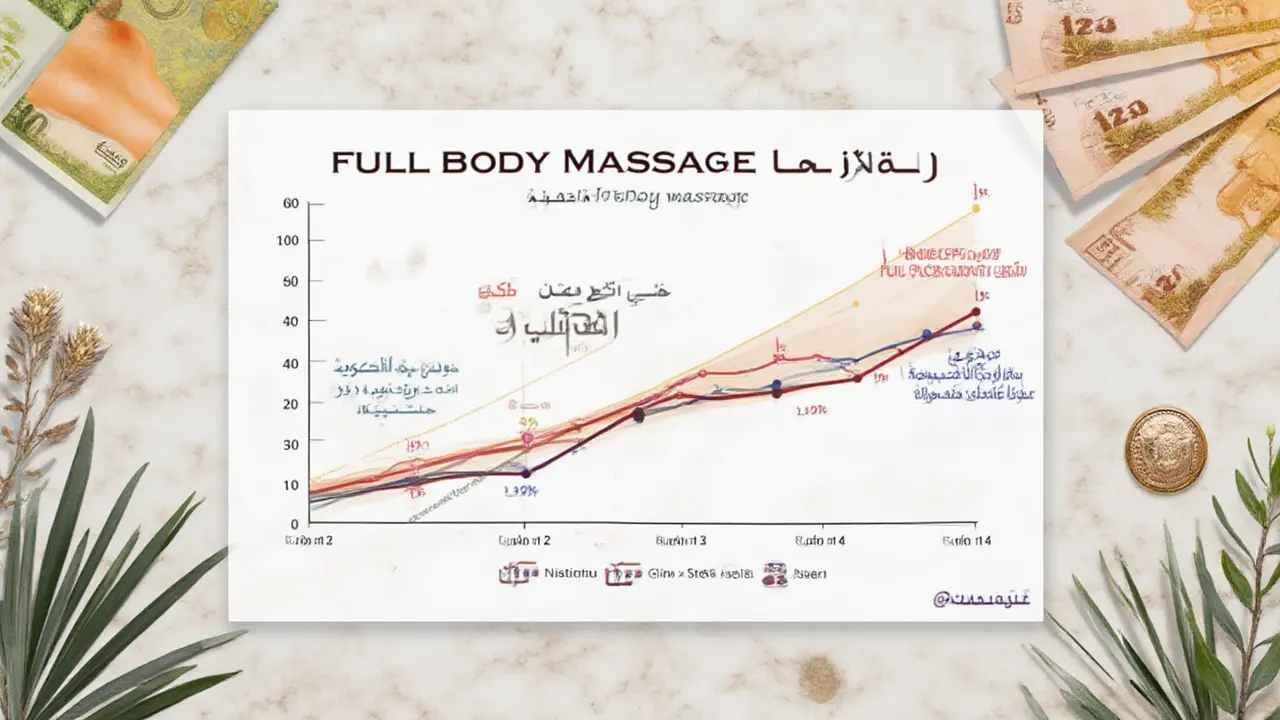How Much Does a Full Body Massage Cost? Your Comprehensive Guide
If you’ve ever winced at a marathon workday or felt your shoulders creep up toward your ears, the idea of a full body massage probably sounds like bliss. But let’s be real—the first question that pops into most people’s minds isn’t about hot stones or soothing music. It's how much is this going to cost me? Searching for the full body massage cost can lead you down a rabbit hole of deals, spa menus, and mysterious package offers that only make things murkier. I’ve been in your shoes, scrolling with curiosity (and a bit of sticker shock the first time). Whether you want a basic Swedish massage, something fancier with luxurious oils, or a true deep tissue fix, prices can feel all over the place. This guide spells out what goes into massage pricing, why it varies so much, what you can expect for your money, and how to maximize your experience. Let’s take the guesswork out of self-care.
Understanding the Basics of Full Body Massage
Origins and History
Full body massage has roots stretching back thousands of years, showing up in records from ancient Egypt, China, and India. In these cultures, touch wasn’t just a luxury. It was part of medicine, used to heal aches, soothe spirits, and keep the body in balance. Over time, techniques evolved—think of the flowing moves of Swedish massage (popularized in Europe in the 1800s), or the acupressure points central to Chinese tuina. Today, spas from Dubai to New York draw on these traditions, blending them with modern comfort and specialized training. Massage has become both an art and a science, tailored to the demands of stressed-out professionals and wellness seekers everywhere.
Core Principles or Components
At its heart, a full body massage works from head to toe, focusing on both muscle relaxation and nervous system calm. Typical elements include gentle warming up of muscles, kneading (effleurage), deeper pressure (petrissage), and maybe even stretching or tapping (percussion). Most treatments last 60 to 90 minutes, although shorter and longer options exist. You’ll almost always be asked about preferences—pressure, sore spots, areas to avoid—and the practitioner will use high-quality oils or lotions. The session usually takes place in a quiet, softly lit room with temperature control, music, and privacy. Communication is key: you can ask for less or more intensity at any point.
How It Differs from Related Practices
Massages come in all shapes and flavors. A full body massage is different from targeted treatments (like just back, neck, or feet), and it’s not the same as physiotherapy, chiropractic adjustment, or beauty-focused therapies (like facials or wraps). Here’s a quick comparison for clarity:
| Practice | Key Feature | Primary Benefit |
|---|---|---|
| Full Body Massage | Head-to-toe muscle relaxation | Stress relief, muscle ease |
| Reflexology | Focus on feet/hands | Balancing energy |
| Physiotherapy | Injury rehab, movement training | Restore physical function |
| Chiropractic | Spinal alignment | Pain relief, mobility |
Who Can Benefit from Full Body Massage?
Almost anyone! Busy professionals, athletes, parents (I get it—my daughter Lorena’s bedtime battles leave me dream-craving a massage), travelers, or anyone looking to manage stress or pain. Pregnant individuals (with proper techniques), older adults, and even teens can all benefit. If your life involves movement, computers, emotional ups and downs, or just a desire to feel good, you’re in the target group. That said, people with certain health conditions should consult a doctor first (we’ll tackle that below).
Benefits of Full Body Massage for Body, Mind, and Beyond
Stress Reduction
Here’s where massage truly shines. When you lie down and relax into a full body session, your nervous system slows. The ‘fight or flight’ stress response switches off, and those tension headaches or clenched jaws start to let go. Many people leave feeling lighter, more relaxed, and less frazzled by daily annoyances. Research by organizations like the National Institutes of Health shows regular massage reduces anxiety, improves mood, and even supports sleep (Web source: https://www.nih.gov/health-information/massage-therapy-what-you-need-know).
Enhanced Circulation & Flexibility
All that stroking and kneading doesn’t just feel good—it literally helps your blood flow. Better circulation can mean faster muscle recovery, fewer cramps, and a general feeling of “ahh, I can finally move!” Some athletes schedule massages as part of their training plans for this very reason. If you’re sitting at a desk or just not moving much, a massage can be like untangling a knotted pair of headphones—everything just works better after.
Emotional Well-Being
Touch has a powerful impact on mental health. Massage isn’t just skin deep; it’s scientifically shown to trigger endorphin release (those “feel good” hormones). People describe greater self-awareness, better mood, and sometimes even a new outlook on their bodies. It’s like a reset button, especially for those carrying emotional tension in their muscles. I’ve had friends admit that massage helped them manage burnout or even break through creative blocks.
Practical Applications
Massage isn’t all about candles and spa music. It’s used in chronic pain management, injury recovery, and as a tool for better posture. Some individuals report fewer headaches, better sleep, and even improved digestion. If you’re pregnant or have a tough time relaxing, a properly trained therapist can adapt the routine to your needs. Whether it’s a once-in-a-while treat or a monthly staple, the impact really depends on your lifestyle and goals.
| Benefit | Description | Impact |
|---|---|---|
| Stress Relief | Soothes nervous system, relaxes muscles | Calmer moods, better sleep |
| Injury Prevention | Improves circulation, flexibility | Reduced muscle tension, less soreness |
| Mental Release | Encourages endorphins | Happier outlook, reduced anxiety |
| Physical Recovery | Custom pressure, stretching | Faster healing post-exercise |
What to Expect When Engaging with Full Body Massage
Setting or Context
Picture this: you arrive at a quiet, softly lit spa, maybe greeted with herbal tea or gentle music. In Dubai, many spa spaces feel ultra-luxe, with calming scents and plush linens. At home, a portable massage table and calming playlist can create a similar vibe. The room is kept cozy, with privacy and all tools within arm’s reach. If you’re at a clinic (like sports recovery or physical therapy), don’t expect incense or waterfalls—just a clean, functional space designed for comfort.
Key Processes or Steps
Here’s the usual drill: You fill out a quick questionnaire about preferences and health issues. The therapist goes over what will happen, you undress (to your comfort level), and hop under a towel or sheet. The massage typically starts with broad, gentle strokes to warm up. The practitioner methodically works head to toe, using varying pressure. If you want a focus on knots or specific muscles, speak up. At the end, there’s time to rest, rehydrate, and ease back into the world. Total time: usually 60-90 minutes (but can range from 45 to 120 depending on package).
Customization Options
There’s no one-size-fits-all. You can request more or less pressure, skip areas, or even add extras (like essential oils or hot stones). Many spas offer pregnancy cushions or sports-focused routines. Language shouldn’t be a barrier either; therapists often check in about comfort and preferences throughout.
Communication and Preparation
Want the best results? Be honest about health issues, injuries, or sensitivities. Don’t be shy—clear communication helps the therapist avoid sore spots, tailor pressure, and maximize relaxation. Drink water before and after the session, and avoid heavy meals. If you’re nervous, ask for a tour or explanation before your first session. There’s no such thing as a silly question—your comfort is the top priority.
How to Practice or Apply Full Body Massage
Setting Up for Success
Whether visiting a spa or trying an at-home massage, the setup matters. Look for soft lighting, clean linens, soothing background music, and a space where interruptions are minimal. If you’re doing this at home, a quality massage oil and a towel can go a long way. If you have pets or kids (like Lorena darting in mid-massage—been there!), try to schedule for a quiet time.
Choosing the Right Tools/Resources
The best investment is a certified, well-reviewed therapist. Look for professional credentials (most countries require certification), and check ratings on reputable websites. For home routines, simple tools like massage rollers, heat packs, or even tennis balls can help stretch or knead sore spots. Avoid ultra-cheap spa deals if the facility looks suspect or reviews mention hygiene concerns. Your body deserves better.
Step-by-Step Guide
For a home massage:
- Create a relaxing environment—soft light, music, warmth.
- Warm-up the oil in your hands before applying.
- Start with broad strokes covering large areas (back, legs, arms).
- Gradually apply more pressure, focusing on tension spots.
- Check-in for feedback or adjust as needed.
- Finish with gentle smoothing moves and let the receiver rest for a few minutes.
Tips for Beginners or Couples
If it's your first massage, start with a basic full body Swedish session. Trust is everything—choose a therapist who listens. For couples, alternate sessions or learn a “guided” routine to practice on each other (many spas offer couples’ classes). Stay hydrated, avoid caffeine beforehand, and plan some downtime after to prolong the calm.

Safety and Ethical Considerations
Choosing Qualified Practitioners/Resources
Spa deals can be tempting, but not all therapists are equally skilled or licensed. Always look for professional memberships (like the American Massage Therapy Association, AMTA) or country-specific qualifications. Good spas post staff credentials and highlight hygiene practices. If you’re unsure, ask to see a certificate or check public reviews—trust your instincts.
Safety Practices
Your health comes first. Reputable spas disinfect beds, linens, and hands between clients. Therapists should ask about allergies, injuries, and comfort levels. Here are some quick safety tips:
| Practice | Purpose | Example |
|---|---|---|
| Sanitization | Prevents infection | Clean tables/lotion bottles |
| Consent | Respects boundaries | Discuss pressure, areas to avoid |
| Hydration | Reduces soreness post-massage | Offer water after session |
| Monitoring Health | Adjusts for medical needs | Ask about injuries or conditions |
Setting Boundaries
A massage should never feel uncomfortable or invasive. Speak up immediately if an area hurts or you want something changed. Good therapists encourage feedback and respect your modesty and comfort with proper draping and clear guidance. Communication is not rude—it's crucial!
Contraindications or Risks
While massage is gentle for most, certain health conditions (like clotting disorders, severe heart disease, skin infections, or recent surgery) may require extra care or approval from a doctor. Pregnant individuals should seek therapists certified for prenatal massage. If you have any doubts, check with a healthcare provider first.
Enhancing Your Experience with Full Body Massage
Adding Complementary Practices
Why stop at just massage? Combine sessions with mindfulness, aromatherapy, or gentle stretching for a real upgrade. Some spas even offer yoga or guided meditation alongside bodywork for a “mind-body double whammy.”
Collaborative or Solo Engagement
If you prefer company, try a couples massage or book sessions with a friend. Solo sessions can be a sacred treat—think of it like a “spa date with yourself.” Some people even use guided audio to meditate during the treatment.
Using Tools or Props
Simple add-ons like heated pads, Chinese Gua Sha stones, or foam rollers can extend the benefits at home between visits. Many therapists use tools to reach deeper muscle layers. Just make sure you (or your therapist) know what they’re doing—improper use can bruise or irritate muscles.
Regular Engagement for Benefits
Like exercise, massage benefits stack up the more regularly you go. Monthly—or even weekly—sessions are recommended for those managing chronic stress or injury. Even a 30-minute chair massage at work can help reset your mood. Consistency is key.
Finding Resources or Experts for Full Body Massage
Researching Qualified Experts/Resources
Look up therapists or spas on trusted directories (many countries have official listings), and don’t be afraid to request references or testimonials. A quick scan of reviews can tell you if clients leave happy and healthy. Government health departments sometimes list certified professionals by city.
Online Guides and Communities
Wellness forums, reputable medical websites, and review platforms are great for tips and real user experiences. Many spas have detailed websites explaining services, prices, and therapist bios. Social media wellness groups or Reddit threads can also offer insight, but always double-check sources before booking.
Legal or Cultural Considerations
Massage therapy is regulated in most places—Dubai, for instance, requires therapists to be licensed. Laws can vary by country and even by city, especially for more specialized treatments. Always choose providers who follow local regulations, including gender policies, privacy rules, and customer service standards. In many cultures, touch is a sensitive topic. Good massage clinics handle scheduling, dressing, and boundaries with respect for religious and personal norms.
Resources for Continued Learning
If you want to dive deeper, check out books on massage theory, anatomy, or specific styles (like Thai or sports massage). Local wellness centers might run classes or workshops for couples or self-care routines. Youtube has guided routines (just stick to channels run by certified therapists). If you fall in love with massage, consider training—some people end up learning the basics and sharing the practice at home with friends or family.
FAQ: Common Questions About Full Body Massage
Here are some of the questions people often ask before booking their first full body massage:
What to expect from a full body massage?
Expect to spend about 60–90 minutes on a soft table, wrapped in cozy linens, as a licensed therapist gently works on all major muscle groups. You’ll start face-down and switch halfway through, with only the area being treated uncovered at any time. Relaxing music, soothing scents, and warm oils make it a multisensory experience. Some people feel energized after, others sleepy or a little sore (totally normal!). Hydration helps speed up recovery.
What happens during a full body massage?
The practitioner will ask about your preferences and any problem spots. Once you’re comfortable, they’ll use a mix of long gliding strokes, kneading, and sometimes gentle stretching or tapping to work out tightness. Communication is encouraged if anything feels off. At the end, most clients are invited to lie still and rehydrate with tea or water, making the transition back to daily life blissful and calm.
How does a full body massage differ from reflexology or localized massage?
Full body massage covers all major muscle groups, while reflexology focuses on specific points (mostly feet, hands, or ears) believed to connect to organs. Localized massage targets areas like the neck, shoulders, or lower back only. If you want total relaxation, go for full body. If you need pain relief in just one spot, localized might be for you.
What is the method of a full body massage?
Most full body massages use Swedish or deep tissue techniques—long strokes to warm up muscles, then more focused kneading to release knots. Oil or cream reduces friction, and pressure varies based on your preference. Therapists check in often to keep you comfortable and safe throughout the session.
Is a full body massage suitable for beginners?
Absolutely. Full body massage is welcoming to first-timers: you can keep underwear on if you wish, choose a therapist of any gender, and request only gentle touch. Reputable spas or clinics walk you through each step and encourage questions before, during, and after. Just let them know you’re new, and they’ll handle the rest.
Why a Full Body Massage is Worth Exploring
A Path to Wellness and Relaxation
If you’re looking to melt physical tension, boost your mood, or just invest in a little “you time,” full body massage is hard to top. From ancient origins to modern spas and clinics, its impact on body and mind is well-proven. The right massage can be like a reset button for both muscles and mental health, and the benefits go way beyond the treatment table.
Try It Mindfully
When booking a massage, take a few seconds for research—choose licensed professionals, communicate your needs, and don’t be afraid to ask questions. With the right guidance, you’ll wonder why you waited so long. Consider pairing sessions with healthy routines for even better results.
Share Your Journey
Tried a full body massage? What was your experience like? Share your thoughts in the comments! Want more wellness tips and spa guides? Follow my blog and explore new ways to keep your body and mind happy. And if you’re curious, book a session this week—let me know how it goes!
Some links may be affiliate links, but all recommendations are based on research and quality.

Suggested Visuals
- A serene spa setting with massage tables, soft lighting, and calming décor
- A professional therapist giving a full body massage in a modern Dubai spa
- Close-up of massage oils, stones, or towels
- Comparison chart: Full body vs. localized massage vs. reflexology
- Infographic on steps of a typical full body massage session
Table Ideas
- Comparison of Full Body Massage vs. Related Practices
- Key Benefits of Full Body Massage
- Safety Tips for Full Body Massage
Word Count: 2250




Maria Biggs
August 1, 2025 AT 16:53Omg, I was literally just thinking about booking a full body massage but had zero clue how much it’d cost! 😅 This post breaks it down nicely. I think prices can be so confusing, especially when you’re new to spas. Sometimes they hit you with those hidden fees that make you want to scream! 🙄
Also, super important tip: always check for reviews before booking. I once went to a place that turned out super shady and ended up with a really awkward experience. Not all massages feel relaxing when you get bad service, lol.
Would love to see more on what you should expect from different types of massages, like deep tissue vs Swedish, so people can pick right for their budget!
Ben Görner
August 2, 2025 AT 04:00This guide is a solid start for anyone curious about spa prices, especially those who’ve never had a massage before. I appreciate how it covers tips for every budget — that inclusivity makes a difference.
Something I always recommend is to ask upfront about the masseuse’s certification and experience, particularly if you have specific issues like back pain or tension. That way, you can make an informed choice while staying safe.
Also, remember to communicate your preferences clearly during the massage for maximum relaxation. Hope this helps some first-timers out there!
Eddie Valdes
August 3, 2025 AT 07:46Honestly, it’s fascinating how the cost of a full body massage varies so wildly across cities and spa types, yet people blindly pay premium prices thinking they’re all the same. Here’s a little secret: most of the true benefits come from the therapist’s skill, not the luxury of the spa itself. So don’t get fooled by glossy waiting rooms! 🤓
If you’re hunting for value, ask about package deals or off-peak pricing — they can save you a ton. Quality massage should never feel like a rip-off.
Vikram Sinha
August 4, 2025 AT 11:33From a philosophical standpoint, the experience of receiving a massage isn’t just about the physical relief but also about the mental state it induces. The investment varies because we’re essentially paying for a kind of temporary escape or ritual that reconnects us to our bodies.
The price might reflect cultural attitudes to self-care, which vary widely. It’s curious how something so ancient as massage is commodified differently across societies.
It’s good to remember that sometimes a simple, mindful touch is more restorative than the fanciest spa package.
Jenn Davenport
August 5, 2025 AT 15:20Wow, I love the detailed breakdown here! It really helps demystify what can seem like a really overwhelming world of spa services. Full body massages are honestly a game-changer when it comes to stress relief.
One thing I’d add is don’t underestimate the power of setting the scene yourself too — like choosing an environment where you can totally relax without distractions.
Also, tossing in a few drops of your favorite essential oil during the massage can elevate the experience SO much! 🌸 Just personal tips from a regular spa enthusiast who’s tried a bunch of places.
Dan Mihai
August 6, 2025 AT 19:06Honestly, anyone looking to truly grasp the economics behind massage pricing must appreciate the nuanced interplay of operational costs, therapist expertise, and clientele demographics. The ostentation at certain spas is often a veneer masking elementary service quality.
One would do well to analyze the amortization of equipment alongside labor costs when assessing value propositions. Always question whether your remuneration aligns with a therapist's actual skill set versus luxurious branding exaggerations.
True aficionados know that elevated prices rarely correlate directly to elevated benefits.
gangadhar balina
August 7, 2025 AT 22:53The discussion about full body massage pricing must be rooted in the recognition of cultural hegemony regarding wellness commodification. In my region, traditional Ayurvedic massages represent an unblemished form of rejuvenation, vastly underappreciated in Western inflated markets.
Consumers are prey to capitalist exploitation when spas feign exclusivity to justify exorbitant fees. An intellectual reassessment of massage philosophy is overdue—especially regarding nationalism and the resurgence of indigenous healing practices.
There is great power in preserving these ancestral methodologies free from commercial predation.
Michelle Yu
August 9, 2025 AT 02:40While many enjoy the relatable simplicity of standard massages, there’s something inherently superior about spas that truly understand bespoke wellness. To settle for anything less is to compromise on an art form.
Prices correlate with an establishment’s ability to curate atmosphere, therapist caliber, and holistic experience. One must recognize that the most exquisite treatments transcend mere manipulation of muscles—they cradle the spirit.
If one desires excellence rather than mediocre relaxation, paying a premium is justified.
Dustin Lauck
August 10, 2025 AT 06:26Oh, sure, you can just slap some oil and press some muscles and call it a day, but a real massage is borderline philosophical in its existential impact. The cynical might say it's just a luxury, but it's an essential human experience — the price tag? Just a number for those who get it.
I've always been amused by people debating cost without acknowledging the intangible benefits: downtime, mindfulness, all the jazz. Price is what you pay; value is what you get, folks.
So yeah, invest wisely, but don’t cheap out on self-care. Your muscles — and your sarcastic soul — will thank you later.
sarah young
August 11, 2025 AT 10:13Hey all, I think this guide’s pretty cool for newbies trying to figure out what’s legit and what’s a total rip-off. Massages can get pricey fast, but they’re sooo worth it for unwinding. 🙌
One thing I've learned: don’t be shy to ask the spa questions before booking. Like, what types of massage they specialize in or if they have any newbie discounts. It’s all about feeling comfy with what you’re paying for, ya know?
Also, a little tip from me: sometimes local spots have killer deals and great vibes without the fancy prices. Worth checking those out if you’re on a budget but crave some R&R!